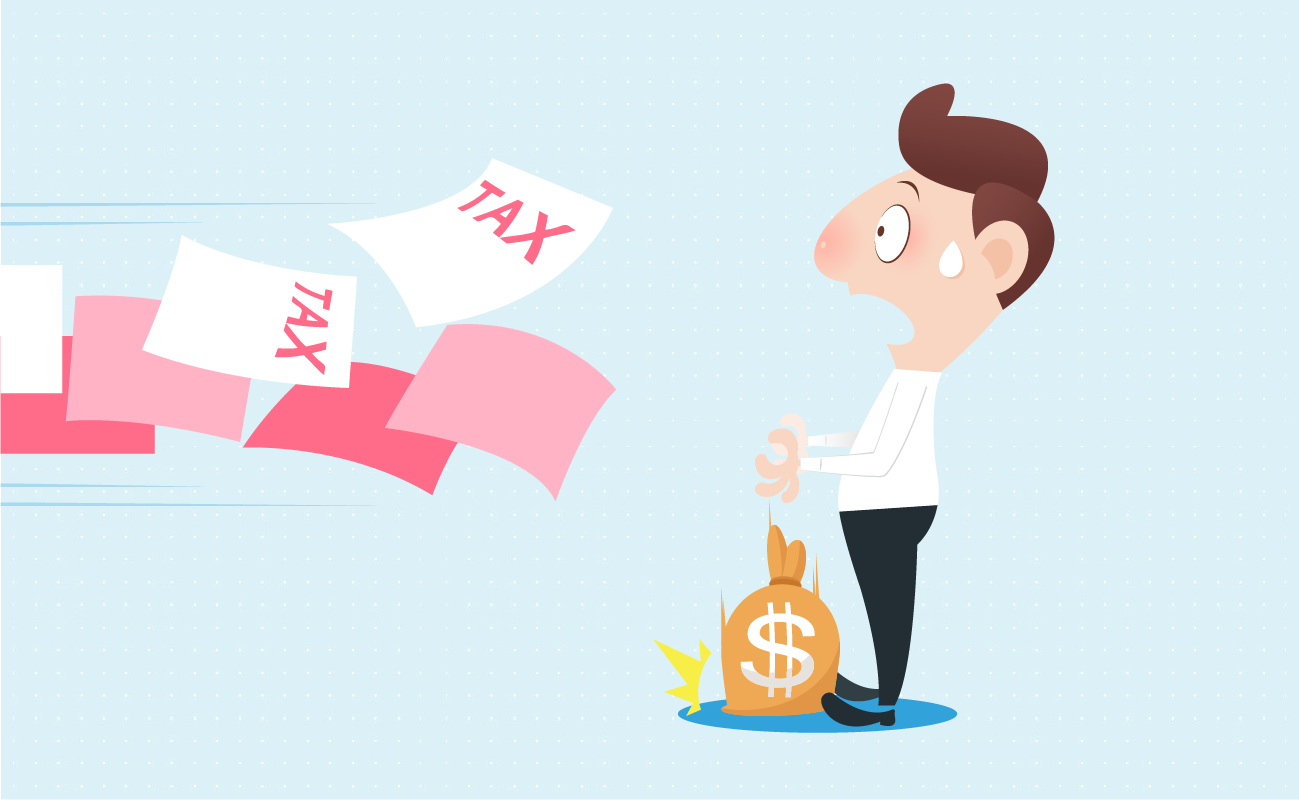Savings Goals
Net Worth
 Tax-deferred Savings Calculator
Tax-deferred Savings CalculatorThis calculator helps investors figure out the future value & annualized yield of various investments. For example, an investor could use this to see how much greater their returns would be if they invested their savings in a tax-deferred instrument like a Roth IRA, or they could see the tax-equivanet yield they would need from a taxable investment to equal the returns on an untaxed investment like certain municipal bonds.
Guide published by Jose Abuyuan on November 4, 2020

Like that purple villain from the superhero movies, taxation is inevitable. The only difference is that you can’t snap your fingers and make it go away. Taxes are vital to the function of the public services we take for granted. Too often, however, people pay more than their fair share. Excessive taxation is one of the biggest hurdles toward building wealth.
While you can’t (and shouldn’t) run away from your taxes, you can reduce the impact they have on your financial status. With the right mix of exemptions and deferments, you can keep your books tax efficient. Tax efficiency is an important part of effective financial planning.
Key tools in your tax efficiency arsenal are tax-deferred and non-taxable investment accounts. These accounts can help reduce the tax burdens on your long-term savings.
You might think that it’s wise to pay taxes today and get it over with. And in most circumstances, this might be the appropriate decision. Why wait for those burdens to pile up? Taxes paid today are better than taxes overdue tomorrow, right? Or are they? Sometimes, however, paying today means paying too much.
Fortunately, there are plenty of ways to manage tax burdens. Here are several methods to reduce taxation’s impact on your finances:
Tax deferral is one of your biggest allies in maintaining tax-efficient retirement portfolios. Postponing taxes can cut down everyday tax burdens while maximizing future returns.

Tax deferred investing aims to help the average person save up for retirement. The larger initial principal you make each time you save tax-deferred adds up over the years. The end result is a larger nest egg for you to live on after you finally leave the workforce.
Deferring taxes puts time on your side in more ways than one. While your income likely grows as you age, it will plummet when you finally retire. By the time you begin making required deductions, you are now in a lower tax bracket. In effect, you’ve earned more money and are now paying lower taxes.
Moreover, a lot can happen in the intervening years between today and retirement. Future changes in tax law can lower your future tax burdens even further.
Traditional individual retirement accounts (IRAs) let you save for retirement as an individual. In contrast to so-called Roth IRAs, these accounts use pre-tax income in investing. As long as your money stays within the account, you pay no taxes.
These accounts came into being in 1974 under the Employee Retirement Income Security Act. They didn’t just provide retirement plans for employees without employer-provided retirement plans. An IRA may also act as a bridge for employees to roll over their investments when they change jobs.
At present, anyone who receives taxable compensation is eligible to save their money in an IRA. Before January 2020, however, older adults above the age of 70 and a half years could not contribute to an IRA. For 2020 and 2021, your maximum contributions for all your IRAs (traditional and Roth) is $6,000. This limit increases to $7,000 for people aged 50 years and above by the end of the year.
You can’t keep the money in your IRA forever. Required distributions begin on the 1st of April following the year you turn 72, or if you reach the age of 70 and a half years before the 1st of January 2020.
Required minimum distributions (RMDs) are the amounts you must withdraw from your retirement accounts. These apply upon reaching a specific age (72 years as of 2020; 70 and a half prior). 401(k) holders must begin making withdrawals once they retire. For IRA holders and people who own at least 5 percent of a business, they must make these withdrawals whether they are retired or not.
To bolster your earnings, you may opt not to touch your retirement funds until required. Your RMD varies with your life expectancy. This is based on several tables available on the IRS website. Although your RMDs are often lower than your present income, that isn’t always the case.
Another benefit of traditional IRA contributions is that they can be tax deductible. Qualification is based on their modified adjusted gross income (MAGI). Since 2020, people who meet the following conditions may apply for an IRA tax deduction:
Individuals whose incomes approach these limits qualify for a smaller tax deduction. For individuals and heads of household, their contributions are reduced if their incomes are between $65,000 and $75,000. For married couples filing jointly, this threshold is between $104,000 and $124,000.
Among the benefits of using tax-deferred investments are their present tax benefit. These benefits provide you with a greater proportion of cash for your everyday needs. This is especially helpful when you’re starting out. You’ll need that extra tax relief to accomplish your other financial goals.
First introduced in 1978, the 401(k) plan replaced the employer-provided long-term pension plans. Unlike IRAs, which you must set up yourself, your 401(k) is set up for you by your employer. Many employers offer 401(k) plans as an option for their employees. A few companies, on the other hand, provide employees with one upon hiring.
401(k) accounts have a much higher annual contribution limit. As of 2020 and 2021, the largest amount you can deposit is $19,500. Those aged 50 years and above can add an extra $6,500 as a catch-up contribution.
Workers often don’t have much control over the matched contributions to a 401(k) at first. You must work a set number of years (up to four) before they give you access to your 401(k). Called “vesting,” this assures the company of your loyalty and retention. Vesting is done in increments of 22 or 33 percent. If you should leave the company before the vesting period lapses, you may only redeem part of your money. This amount will depend on how many years you have worked.

If you want to change careers but have invested a lot on your current 401(k), you may wait for your vesting period to lapse. Fortunately, career changes are not usually urgent affairs.
Because your 401(k) account is tied to your employer, you might be worried about what happens if they ever close. Fortunately, they can be rolled over to a different account, such as an IRA or another 401(k), if this happens.

Once you place your money in a tax-deferred investment account, keep it there. Both accounts have severe taxation penalties if you withdraw money from them prematurely. Doing so results in a hefty 10 percent taxation penalty on top of the taxes you also owe.

Unless your financial situation is dire, never withdraw from your tax-deferred investments.
If you’ve ever found yourself at a career crossroads, you might be worried about the fate of your 401(k). What happens to the money you’ve kept there? Never fear! Simply open an IRA (if you don’t have one already) and roll over the funds from your accounts in the span of 60 days. This way, you avoid the hefty taxation penalties that come with premature withdrawals. Rollovers are also exempt to the annual contribution limits set by the Internal Revenue Service (IRS).
In addition, you have the option to leave your old 401(k) with your previous employer if the returns are robust. Consider this option with care, however. Employers might charge you higher management fees if you are not an active employee. You may also not make active contributions to that account.
It isn’t uncommon for people to have multiple 401(k) accounts from previous employers. But many people fail to claim all of them. This is money working for you that goes to waste. Rolling over can help you consolidate your accounts into your most recent one. This allows you to keep better track of your investments.
In normal circumstances, you may only rollover your accounts once. Key exceptions include rolling over money from a traditional to a Roth IRA account.

Conclude rollovers as fast as possible. Make sure that money is transferred to a tax-deferred investment. Tax penalties notwithstanding, you may also lose out on future gains if you don’t put that money back.
Tax-deferred investments are not the only way to manage taxes. Roth accounts, funded with post-tax income, can secure tax-free future returns. In many circumstances, you might not always consider a Roth IRA or 401(k). They have a much lower qualifying limit than tax-advantaged investments, however. To be eligible, your annual income must not exceed the following limits:
The cap for all IRAs applies to both Roth and traditional IRAs. If you max out your traditional IRA contributions, you cannot add to a Roth IRA outside a conversion.
A Roth conversion is the transfer of money from a traditional IRA or 401(k) account to a Roth account. The money you take out will be charged in today’s taxes and grow tax-free afterward. In some circumstances, prospective retirees are tempted to move their pre-tax earnings to a Roth account.
Depending on your financial situation, this may be a good call. Some people’s incomes drop before retirement. Once they do retire, their incomes might put them in a higher tax bracket. Others are motivated more by uncertainty and fear. Changes in tax structures, they argue, may be just around the corner.
Regardless of the reason, Roth conversions must be done with caution. Don’t do it all at once. You may end up paying nearly half your earnings to taxes this way. Adjust your conversions based on your taxes for the year to lower your total tax burden.

How much more you can earn from a tax-deferred investment depends on several factors. Among the considerations include your future income and your current earning capacity. Look at your whole financial picture before deciding where to put your money. Don’t be too hasty when making big decisions.
In raw returns and present tax benefits, deferring your investments make perfect sense. A higher principal through tax deferment leads to higher yields in the future. The tax benefits they provide also opens up more of your take-home cash flow for other purposes. You can earn tax-deferred while paying off your debts.
In our example, let’s assume you’ve maxed out your year’s IRA and 401(k) contribution, a grand sum of $25,000. Taken together, your investments have an annual percentage yield (APY) of 7 percent. Your marginal tax rate at the state and federal levels is 22 percent. In about 30 years, you can expect to be taxed at 3.8 percent.
All things being equal, let’s see how much your accounts will make compared with a post-tax investment:
Principal: $25,000.00
Rate (APY): 7%
Term: 30 years
Marginal Tax Rate (State and Federal): 22%
Taxable Rate of Deferred Saving: 3.8%
| Results | Taxable | Tax-Deferred |
|---|---|---|
| Future Value | $123,189.31 | $187,208.56 |
| Annualized Yield | 5.46% | 6.94% |
Tax deferment hinges on your future taxes being lower than what you expect to pay today. But not everybody can enjoy paying lower taxes later. Low-income individuals, for instance, might find that their incomes can only go up as time goes by. To preserve their income streams at the end of retirement, investing tax-free is a good option.
Investing in after-tax dollars also works if you expect your RMDs to bump up your income. The high tax burden can pose a challenge if you expect to pay for medical bills and other big expenses.
Capital gains taxes are charged from the gains you made through investments. Investments that grow in value over time are subject to this tax, but they are not taxed the same way. How much your taxes will cost depends on how long you plan to hold onto your assets. The much higher taxes apply to short-term capital gains. Hold on to a property for more than a year, on the other hand, and your gains fall under long-term capital gains taxes.
The following table shows the short-term capital gains tax rates for households as of 2020:
| Rate | Single | Married filing Jointly | Head of Household | Married filing Separate |
|---|---|---|---|---|
| 10.00% | $0 – $9,875 | $0 – $19,750 | $0 – $14,100 | $0 – $9,875 |
| 12.00% | $9,876 – $40,125 | $19,751 – $80,250 | $14,101 – $53,700 | $9,876 – $40,125 |
| 22.00% | $40,126 – $85,525 | $80,251 – $171,050 | $53,701 – $85,500 | $40,126 – $85,525 |
| 24.00% | $85,526 – $163,300 | $171,051 – $326,600 | $85,501 – $163,300 | $85,526 – $163,300 |
| 32.00% | $163,301 – $207,350 | $326,601 – $414,700 | $163,301 – $207,350 | $163,301 – $207,350 |
| 35.00% | $207,351 – $518,400 | $414,701 – $622,050 | $207,351 – $518,400 | $207,351 – $311,025 |
| 37.00% | $518,401 and up | $622,051 and up | $518,401 and up | $311,026 and up |
Now compare the long-term capital gains taxes from the same year:
| Rate | Single | Married filing Jointly | Head of Household | Married filing Separate |
|---|---|---|---|---|
| 0.00% | $0 – $40,000 | $0 – $80,000 | $0 to $53,600 | $0 to $40,000 |
| 15.00% | $40,001 – $441,451 | $80,001 – $496,600 | $53,601 to $469,050 | $40,001 to $248,300 |
| 20.00% | $441,451 and up | $496,601 and up | $469,051 and up | $248,301 and up |
Fortune, in this case, favors the patient. You gain the most benefits from assets like real estate and stocks gain by holding them for a longer period. Thus, you often won’t be in a hurry to get rid of them anytime soon. Even if you must sell a property (such as a house) on short notice, it often pays to time it right. You stand to save a lot of money if you qualify for long-term capital gains taxes.

Be conscientious when holding or selling assets. Sometimes the losses you incur from holding onto a declining asset is more than what you might owe in capital gains taxes. Take the tax hit and cut your losses.
Other tax-advantaged investments include municipal bonds and treasury bills. These debt securities are among the most secure investments available. Although they have low returns, they can provide you with a quick return to your investment with few debt burdens.
Also known as “munis,” municipal bonds are cash investments issued by city governments. Their aim is to help fund local government projects. These are exempt from federal and, depending on the area, state and local taxes. Depending on where you live, you can lend money to the city and expect a tax-free payout.
Treasury bills, meanwhile, are debt securities backed by the federal government. These so-called T-bills come in increments of $1,000.They mature in less than a year. Although their interest earnings are subject to federal taxes, they aren’t taxable at the state and local level. Moreover, you can lower your tax burden by asking the treasury to withhold up to 50 percent of your interest earnings. These make them an excellent addition to your tax planning strategy.
These are, of course, cash investments that come with associated risks. Municipal bonds might default or be subject to alternate income taxes. Treasury bills are more secure, but are also vulnerable to inflation.

Although taxes are unavoidable, they can be managed to reduce their impact. Many investors overlook tax management and efficiency when creating their investment game plans. By overcoming this glaring oversight, you would’ve added a considerable amount of cash into your accounts. That’s more of your hard-earned money to keep.
Also remember that tax efficiency should not be the end game. Don’t let taxation woes get in the way of aggressive investing elsewhere. You might miss out on big gains if you focus entirely on choosing the investments with the lowest tax bill. Acknowledge tax management’s importance but never lose sight of the big picture.
Make the most of your tax-deferred contribution. If you can, max out your contributions to both your 401(k) and IRA. Take advantage of your employer’s contribution matches by depositing as much as you can. Never say no to free money.
Leave no stone unturned when diversifying your investments. You’ll never know when a tax-advantaged or tax-deferred option might work best for your present situation. Be patient and wait for the long game. It works out in the end.
Another way you can save money and build wealth is by paying down your mortgage. Check out our guide on our accelerated payments calculator.
Jose Abuyuan is a web content writer, fictionist, and digital artist hailing from Las Piñas City. He is a graduate of Communication and Media Studies at San Beda College Alabang, who took his internship in the weekly news magazine the Philippines Graphic. He has authored works professionally for over a decade.